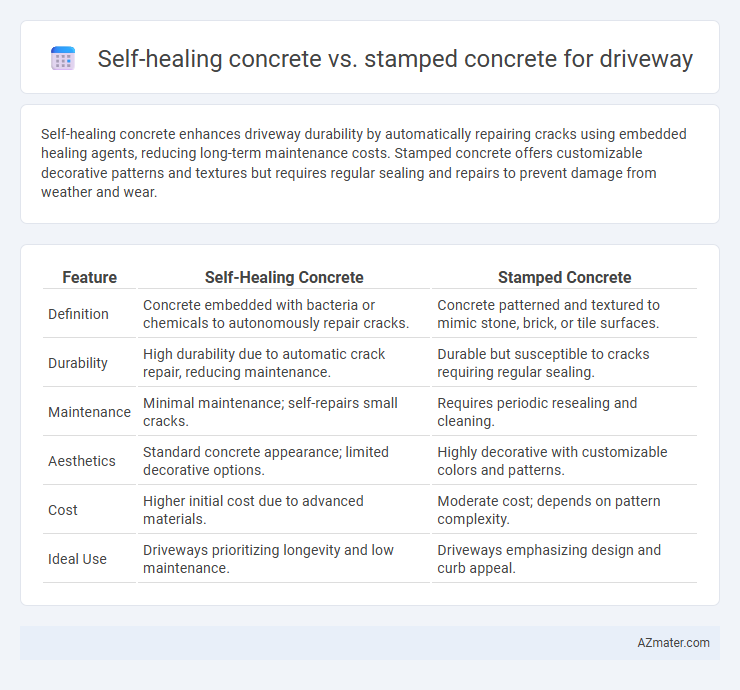Self-healing concrete enhances driveway durability by automatically repairing cracks using embedded healing agents, reducing long-term maintenance costs. Stamped concrete offers customizable decorative patterns and textures but requires regular sealing and repairs to prevent damage from weather and wear.
Table of Comparison
| Feature | Self-Healing Concrete | Stamped Concrete |
|---|---|---|
| Definition | Concrete embedded with bacteria or chemicals to autonomously repair cracks. | Concrete patterned and textured to mimic stone, brick, or tile surfaces. |
| Durability | High durability due to automatic crack repair, reducing maintenance. | Durable but susceptible to cracks requiring regular sealing. |
| Maintenance | Minimal maintenance; self-repairs small cracks. | Requires periodic resealing and cleaning. |
| Aesthetics | Standard concrete appearance; limited decorative options. | Highly decorative with customizable colors and patterns. |
| Cost | Higher initial cost due to advanced materials. | Moderate cost; depends on pattern complexity. |
| Ideal Use | Driveways prioritizing longevity and low maintenance. | Driveways emphasizing design and curb appeal. |
Introduction to Self-Healing and Stamped Concrete
Self-healing concrete incorporates microcapsules or bacteria that activate upon cracking to repair damage autonomously, enhancing durability and extending the lifecycle of driveways. Stamped concrete, on the other hand, involves embossing patterns and textures onto freshly poured concrete to mimic materials like stone, brick, or wood, providing aesthetic appeal and customization. Choosing between self-healing and stamped concrete depends on whether structural longevity or decorative design is the primary priority for the driveway.
How Self-Healing Concrete Works
Self-healing concrete contains microcapsules or bacteria that activate when cracks form, releasing healing agents that fill and seal the damage, effectively restoring structural integrity and preventing further deterioration. This innovative material enhances driveway durability by autonomously repairing minor cracks, reducing maintenance costs over time. In contrast, stamped concrete offers aesthetic appeal but lacks self-repair capabilities, making self-healing concrete a superior long-term solution for driveway longevity.
The Process of Creating Stamped Concrete
The process of creating stamped concrete for driveways involves pouring a fresh layer of concrete and imprinting patterns or textures using specialized molds before the surface fully sets, allowing it to mimic materials like stone, brick, or wood. Color can be integrated through dyes or stains, enhancing the aesthetic appeal and providing a durable, weather-resistant finish that is suitable for various climates. Unlike self-healing concrete, which incorporates bacteria or polymers to repair cracks automatically, stamped concrete relies on surface design techniques and protective sealants to maintain its appearance and structural integrity over time.
Durability: Self-Healing vs Stamped Concrete
Self-healing concrete offers superior durability for driveways due to its ability to autonomously repair microcracks, significantly reducing maintenance and extending lifespan. In contrast, stamped concrete, while visually appealing, lacks self-repair mechanisms and is more prone to cracking and weather-related damage over time. The innovative properties of self-healing concrete make it a more resilient choice for long-term driveway applications compared to traditional stamped concrete.
Aesthetic Appeal and Customization Options
Self-healing concrete offers a sleek, modern aesthetic with a smooth, uniform surface that maintains its appearance over time by automatically repairing cracks, making it ideal for driveways seeking low maintenance elegance. Stamped concrete provides extensive customization options with a variety of patterns, textures, and colors that can mimic natural stone, brick, or tile, allowing homeowners to create a unique and decorative driveway. Choosing between the two hinges on prioritizing either the innovative durability and clean look of self-healing concrete or the versatile design possibilities of stamped concrete.
Installation Process Comparison
Self-healing concrete installation involves embedding microcapsules or bacteria within the mix, requiring precise material handling and controlled curing to activate the self-repair mechanism, which can extend project timelines and demands specialized expertise. Stamped concrete installation starts with pouring a traditional concrete slab, followed by expertly pressing patterns and textures onto the surface while still pliable, allowing for quicker completion and more flexible design customization. Both methods necessitate proper subgrade preparation and curing, but self-healing concrete's novelty may involve higher upfront labor costs compared to the more established, decorative stamping technique.
Maintenance Requirements for Both Concrete Types
Self-healing concrete drastically reduces maintenance requirements by autonomously repairing cracks through embedded healing agents, minimizing water infiltration and structural damage over time. Stamped concrete demands regular sealing and periodic crack repairs to maintain its aesthetic appearance and prevent moisture penetration that can cause deterioration. Homeowners choosing between these options should consider self-healing concrete's long-term cost savings on maintenance versus the frequent upkeep necessary for preserving stamped concrete's decorative finish.
Cost Analysis: Short-term and Long-term
Self-healing concrete incurs higher initial costs due to advanced materials and technology but reduces long-term expenses via decreased maintenance and extended durability. Stamped concrete offers lower upfront costs with aesthetic versatility but may require frequent repairs and resealing, increasing lifetime costs. Evaluating total cost of ownership, self-healing concrete proves more economical over decades, while stamped concrete suits short-term budget constraints.
Environmental Impact and Sustainability
Self-healing concrete enhances driveway sustainability by reducing maintenance needs and extending lifespan through autonomous crack repair using bacteria or microcapsules, minimizing resource consumption and waste. Stamped concrete, while aesthetically versatile, typically requires higher initial energy due to intricate molding and often uses chemical sealants that may emit volatile organic compounds (VOCs), impacting environmental quality. Choosing self-healing concrete supports eco-friendly construction by lowering carbon footprint and promoting long-term durability compared to traditional stamped concrete.
Choosing the Best Concrete Solution for Your Driveway
Self-healing concrete offers enhanced durability and reduced maintenance by automatically repairing cracks, making it ideal for long-term driveway resilience in regions with freeze-thaw cycles. Stamped concrete provides aesthetic customization with patterned textures and colors, perfect for homeowners prioritizing curb appeal and design versatility. Choosing the best concrete solution depends on balancing maintenance needs, environmental conditions, and desired visual impact for your driveway.

Infographic: Self-healing concrete vs Stamped concrete for Driveway
 azmater.com
azmater.com